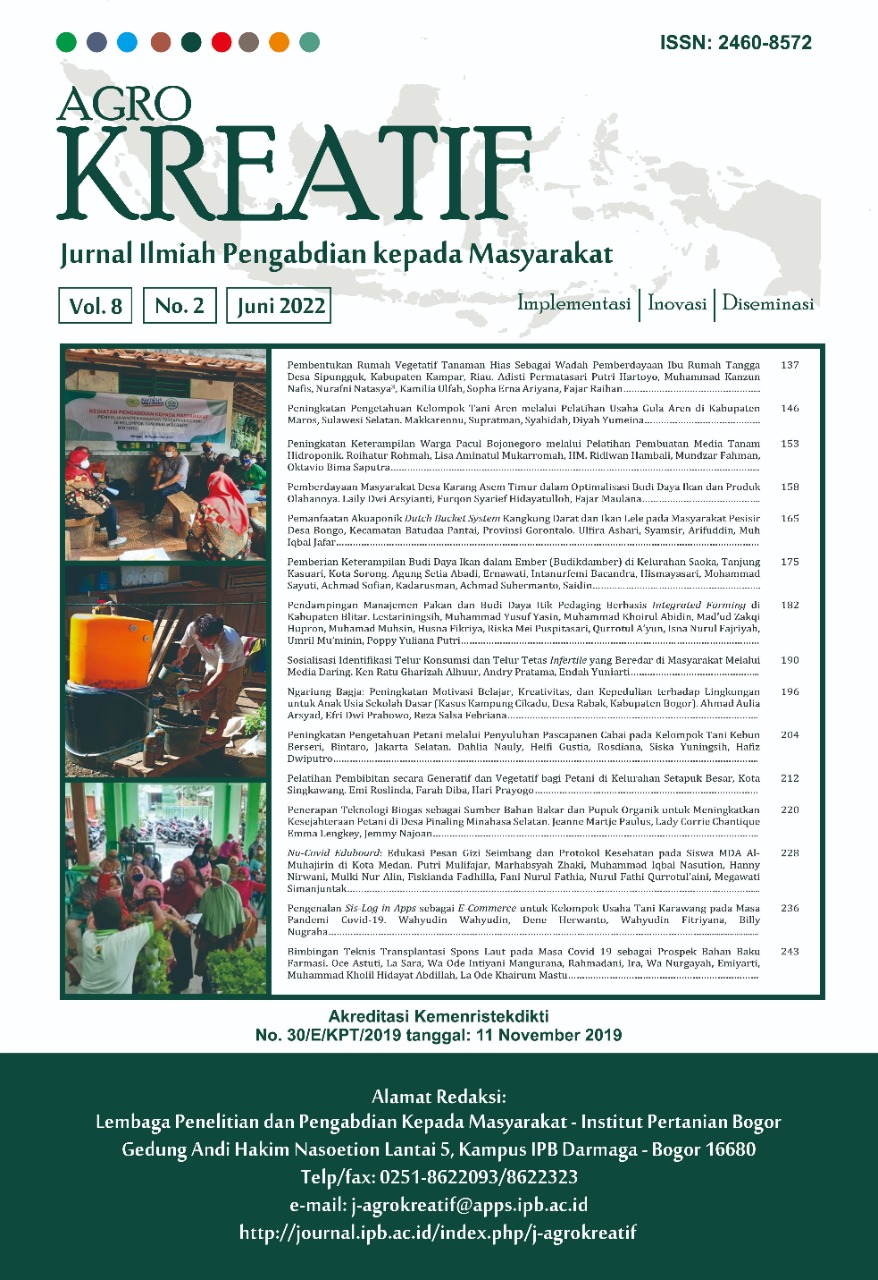Ngariung Bagja: Peningkatan Motivasi Belajar, Kreativitas, dan Kepedulian terhadap Lingkungan untuk Anak Usia Sekolah Dasar (Kasus Kampung Cikadu, Desa Rabak, Kabupaten Bogor)
Abstract
The education sector is one of the sectors most affected by the COVID-19 pandemic. The policies set by the government as an effort to prevent the transmission of the Covid-19 virus have forced face-to-face learning activities to be temporarily suspended or carried out online. However, online learning certainly requires students and educators to have good devices and internet network access. In an effort to increase children's learning motivation, make them more open and able to express creativity through fun learning, a non-formal education program called Ngariung Bagja was compiled. The Ngariung Bagja program was implemented in Cikadu Sub-Village, Rabak Village, Bogor District, with the exact location at SDN Rabak 02. Based on the activities in the Ngariung Bagja program, a number of 12 children aged 9‒12 years experienced increased motivation to read, write, and tell stories. In addition, they can express creativity and art according to their respective interests and talents in the creation stage and produce plastic goods creations as a form of concern for the environment.
Downloads
References
Aji RHS. 2020. Dampak covid-19 pada pendidikan di Indonesia: sekolah, keterampilan, dan proses pembelajaran. Salam: Jurnal Sosial & Budaya Syar-i. 7(5): 395‒402. https://doi.org/10.15408/sjsbs.v7i5.15314
Burhanuddin CI, Abdi MN. 2020. Ancaman Krisis Ekonomi Global Dari Dampak Penyebaran Virus Corona (COVID-19). AkMen Jurnal Ilmiah. 17(1): 90–98. https://doi.org/10.37476/akmen.v17i4.1124
Hadiwidjaja G, Paladines C, Wai-Poi M. 2013. The Many Dimensions of Child Poverty in Indonesia: Patterns, Differences and Associations. [Internet]. [diakses pada: 11 April 2022]. Tersedia pada: https://scholar.google.com/scholar?hl=en&as_sdt=0%2C5&q=The+Many+Dimensions+of+Child+Poverty+in+Indonesia%3A+Patterns%2C+Differences+and+Associations&btnG=
Kalida M. 2016. Gerakan literasi melalui pembelajaran kreatif di Taman Bacaan Masyarakat (TBM). Jurnal Akrab. 7(1): 75‒87.
Kvieskienė G, Ivanova I, Trasberg K, Stasytytė V, Celiešienė E. 2021. Modeling of social policy and initiatives under COVID-19: Rural NEET Youth Case Study. Social Sciences. 10(10):1‒12. https://doi.org/10.3390/socsci10100393
Lund TJ, Liang B, Sepulveda J, White AE, Patel K, Mousseau AMD, Spencer R. 2021. Parenting and Youth Purpose: Fostering Other-Oriented Aims. Youth. 1(1): 2‒13. https://doi.org/10.3390/youth1010002
Miradj S, Sumarno. 2014. Pemberdayaan masyarakat miskin, melalui proses pendidikan nonformal, upaya meningkatkan kesejahteraan sosial di kabupaten halmahera barat. Jurnal Pendidikan dan Pemberdayaan Masyarakat. 1(1): 101‒112. https://doi.org/10.21831/jppm.v1i1.2360
Munajim A, Barnawi, Fikriyah. 2020. Pengembangan kurikulum pembelajaran di masa pandemi. Jurnal Riset Pedagogik. 4(2): 285‒291. https://doi.org/10.20961/jdc.v4i2.45288
Muttaqin T. 2018. Determinate of unequal access to and quality of education in Indonesia. Jurnal Perencanaan Pembangunan. 2(1): 1‒19. https://doi.org/10.36574/jpp.v2i1.27
Sari RP, Tusyantari NB, Suswandari M. 2021. Dampak pembelajaran daring bagi siswa sekolah dasar selama covid-19. Jurnal ilmiah Pendidikan. 2(2): 127‒132. https://doi.org/10.37478/jpm.v2i1.732
Sudrajat A. 2011. Mengapa pendidikan karakter?. Jurnal Pendidikan Karakter. 1(1): 47‒58.
Suripto, Subayil L. 2020. Pengaruh tingkat pendidikan, pengangguran, pertumbuhan ekonomi dan indeks pembangunan manusia terhadap kemiskinan di D.I. Yogyakarta periode 2010-2017. Jurnal Ilmiah Ekonomi Pembangunan. 1(2): 127‒142.
This work is licensed under a Creative Commons Attribution-NonCommercial 4.0 International License.



















